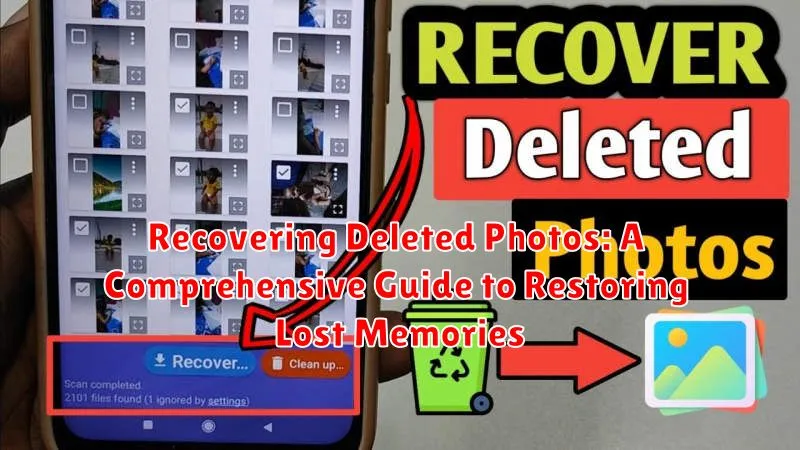Losing precious photos can be a devastating experience. Whether due to accidental deletion, a corrupted storage device, or a software malfunction, the prospect of losing cherished memories can be incredibly distressing. This comprehensive guide explores various methods for recovering deleted photos, offering practical advice and step-by-step instructions to help you restore lost memories. We’ll cover everything from simple undelete operations to more advanced photo recovery techniques, empowering you to retrieve those seemingly irretrievable images.
This guide will delve into the various reasons behind photo loss, discussing common scenarios and offering preventative measures for the future. We’ll examine different photo recovery software options, outlining their features and explaining how to use them effectively. We will also explore manual data recovery methods and discuss the importance of acting quickly when photos are lost. By understanding the deleted photo recovery process, you’ll be better equipped to handle these situations and increase your chances of successfully restoring lost photos.
Understanding Photo Deletion and Recovery
When you delete a photo, it isn’t immediately erased from your device’s storage. Instead, the system marks the space occupied by the photo as available for new data. Think of it like removing a book from a library shelf and marking the spot as empty. The book isn’t gone, but the library considers the space free to use.
This is why prompt action is crucial for successful photo recovery. The longer you wait after deletion, the higher the chance that the system overwrites the “empty” space with new files, effectively erasing your deleted photo. Until overwritten, specialized recovery tools can scan for these “deleted” files and restore them.
Data recovery works by identifying these marked spaces and reconstructing the deleted files. The success of this process depends on several factors, including how long ago the photo was deleted and the level of activity on the device since the deletion. Recovery is not always guaranteed, especially if the storage space has been overwritten.
Common Scenarios of Photo Loss
Losing precious photos can occur in various situations. Understanding these scenarios can help you take preventative measures and increase your chances of recovery.
Accidental Deletion is perhaps the most frequent cause. A simple mis-tap while browsing your gallery can lead to unintentionally deleting photos. Similarly, formatting a memory card or accidentally deleting files during transfer can also result in photo loss.
Device Damage or Malfunction is another significant contributor. Physical damage to your phone or storage media, like a cracked screen or corrupted SD card, can make your photos inaccessible. Software issues, such as a failed operating system update, can also corrupt data and lead to photo loss.
Theft or Loss of the device itself is a devastating scenario. If your phone is stolen or lost, the photos stored on it are also gone. This emphasizes the importance of regular backups.
Built-in Recovery Options on Your Phone
Many modern smartphones include built-in features designed to help users recover deleted photos. These options often leverage a recently deleted folder or album where deleted photos are temporarily stored before being permanently erased.
Recently Deleted Albums: Most phones have a recently deleted folder, typically found within the default photo app. Deleted photos reside in this folder for a limited time, usually 30-40 days, allowing for easy recovery. Simply navigate to the folder, select the photos you wish to recover, and choose the restore option.
Trash or Bin Features: Similar to the recently deleted folder, some phones feature a trash or bin specifically for photos. The functionality and retention period are generally the same as a recently deleted folder.
Manufacturer Specific Tools: Some phone manufacturers provide their own recovery tools within their proprietary gallery apps or file managers. Check your phone’s user manual or support documentation for information on these features.
Utilizing Cloud Storage Services for Recovery
Cloud storage services often provide a safety net for lost photos. If you had automatic backup enabled, deleted photos might reside in your cloud’s recently deleted or trash folder.
Most services retain deleted items for a specific period, typically 30 to 60 days, allowing you to restore them within that timeframe. Access your cloud account via web browser or mobile app and navigate to the appropriate section to retrieve these photos. Check the specific policies of your cloud provider for their data retention period and recovery process.
Even if automatic backup wasn’t activated, if the photos were previously uploaded to your cloud storage, they might still be available. Review your cloud folders to confirm their presence and download them back to your device.
Popular cloud storage services include Google Photos, iCloud, Dropbox, Microsoft OneDrive, and others. Each service has its own method of recovering deleted files. Refer to their help documentation for detailed instructions.
Effective Photo Recovery Apps and Software
When built-in recovery options and cloud services fall short, specialized photo recovery software can be a valuable resource. These tools often employ advanced algorithms to scan storage devices for remnants of deleted files, including photos. Choosing the right software is crucial, as compatibility with your operating system and storage device type (e.g., internal memory, SD card) is essential. Carefully evaluate user reviews and features before making a selection.
Key features to consider include support for various photo formats (JPEG, RAW, PNG, etc.), compatibility with your device’s file system, and the ability to preview recoverable photos before restoration. Some software options may also offer additional capabilities such as repairing corrupted photo files. Remember to install recovery software on a different drive than the one containing the lost photos to avoid potential overwriting of recoverable data.
Some reputable options available include Recuva (Windows), Disk Drill (Windows, macOS), and PhotoRec (Windows, macOS, Linux). Thoroughly research any chosen software to understand its usage, limitations, and potential risks before proceeding with the recovery process. Always exercise caution and back up any recovered photos to a secure location promptly.
Tips to Increase Recovery Success

Acting quickly is crucial for successful photo recovery. The sooner you realize photos are missing, the better your chances of retrieving them. Continued device usage can overwrite the deleted data, making recovery difficult or impossible. Therefore, immediately stop using the device from which the photos were deleted.
Choosing the right recovery software is also vital. Look for reputable software with positive reviews and features specific to your device and operating system. Free software may seem appealing but often lacks the advanced capabilities of paid options, which can be important for complex recovery scenarios.
Properly installing and using the software is essential. Carefully follow the software’s instructions and avoid installing it on the same drive where the lost photos resided. This prevents potential overwriting of the deleted files. Previewing recoverable photos before initiating the recovery process can help confirm you’re targeting the correct files.
Preventive Measures to Avoid Future Photo Loss
Losing photos can be devastating. Taking proactive steps to safeguard your precious memories is crucial. Here are some key strategies to prevent future photo loss:
The 3-2-1 Backup Strategy
This strategy involves having three copies of your photos on two different media types, with one copy stored offsite. This ensures redundancy and protects against various data loss scenarios.
Cloud Storage
Utilize cloud storage services as a convenient offsite backup solution. Ensure automatic uploads are enabled for real-time protection.
External Hard Drives
Invest in a reliable external hard drive and regularly back up your photos. Consider a drive with sufficient storage capacity for your needs.
Physical Media
While less common now, burning photos to DVDs or Blu-ray discs provides a physical offline backup, albeit slower and less convenient.
Safe Device Handling
Practicing safe device handling can also prevent photo loss. Eject devices safely, avoid dropping your phone or camera, and keep devices away from extreme temperatures and moisture.
Restoring Deleted Photos from Social Media and Messaging Apps

Recovering deleted photos from social media and messaging apps requires a platform-specific approach. Each platform has its own data retention policies and recovery mechanisms.
Check Recently Deleted Folders: Many platforms, like Facebook, Instagram, and WhatsApp, have recently deleted or archived folders where deleted photos might reside for a short period. Check these locations first for easy recovery.
Contact Platform Support: If photos are not in the recently deleted area, contacting the platform’s support team might be an option. While not always guaranteed, they may be able to assist in retrieving lost photos depending on their data retention policies.
Backup and Sync: Regularly backing up your photos and syncing them across devices is a crucial preventive measure. Cloud services or device backups can often restore photos deleted from individual apps.

